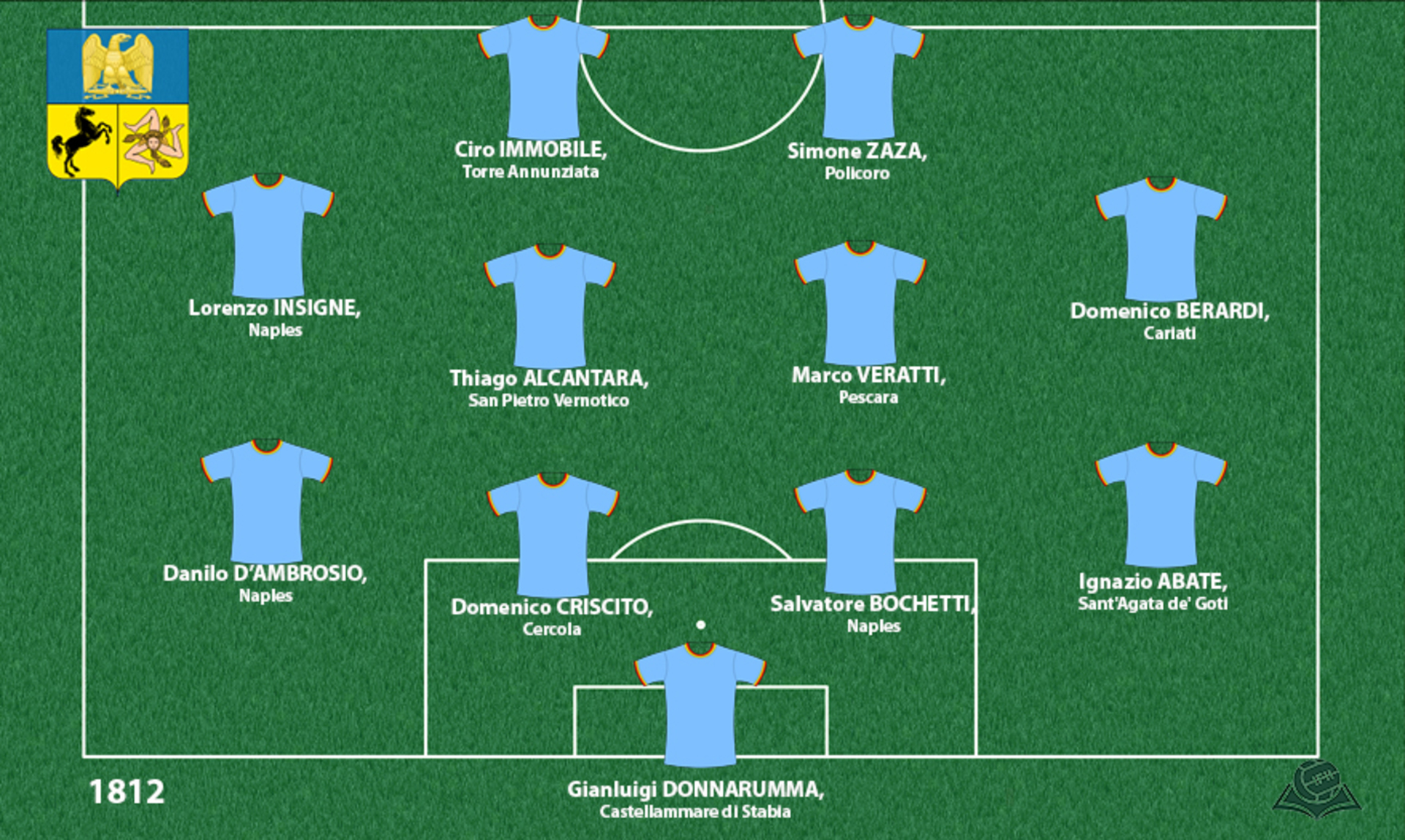Kingdom of Naples
During the Napoleonic wars, the kingdom of Naples represented an area of constant revolutionary and counter-revolutionary events.

Coat of arms

Shirt
| Position | First name | Last name | Mjesto rođenja | Like | Dislike | |
|---|---|---|---|---|---|---|
| GK | Antonio | MIRANTE | Castellammare di Stabia |
1 |
1 |
|
| GK | Gianluigi | DONNARUMMA | Castellammare di Stabia |
16 |
4 |
|
| DC | Paolo | CANNAVARO | Naples |
6 |
1 |
|
| DRC | Armando | IZZO | Naples |
1 |
1 |
|
| DLC | Domenico | CRISCITO | Cercola |
4 |
1 |
|
| DLC | Salvatore | BOCCHETTI | Naples |
2 |
1 |
|
| DLC | Sebastiano | LUPERTO | Lecce |
1 |
0 |
|
| DRL | Danilo | D'AMBROSIO | Naples |
3 |
0 |
|
| DR | Gaetano | LETIZIA | Naples |
1 |
0 |
|
| DR/AMR | Ignazio | ABATE | Sant'Agata de' Goti |
5 |
0 |
|
| DL | Cristian | MOLINARO | Vallo della Lucania |
1 |
0 |
|
| DL/ML | Giuseppe | PEZZELLA | Naples |
4 |
0 |
|
| DMC/DC | Rolando | MANDRAGORA | Naples |
4 |
0 |
|
| MC | Antonio | NOCERINO | Naples |
3 |
1 |
|
| MC | Marco | VERATTI | Pescara |
7 |
0 |
|
| MC | Simone | MISSIROLI | Reggio Calabria |
1 |
0 |
|
| MC | Thiago | ALCANTARA | San Pietro Vernotico |
18 |
1 |
|
| MLC | Jacopo | DEZI | Atri |
1 |
1 |
|
| AMRLC | Luca | GARRITANO | Cosenza |
1 |
0 |
|
| AMRC | Ferdinando | DEL SOLE | Naples |
0 |
0 |
|
| AMRL | Camilo | CIANO | Marcianise |
2 |
0 |
|
| AMRL/SS | Lorenzo | INSIGNE | Naples |
10 |
3 |
|
| FRLC | Domenico | BERARDI | Cariati |
19 |
2 |
|
| FRLC | Fabio | QUAGLIARELLA | Castellammare do Stabia |
11 |
0 |
|
| FC | Ciro | IMMOBILE | Torre Annunziata |
9 |
3 |
|
| FC | Graziano | PELLE | San Cesario di Lecce |
12 |
3 |
|
| FC | Marcello | TROTTA | Santa Maria Capua Vetere |
0 |
2 |
|
| FC | Simone | ZAZA | Policoro |
4 |
2 |
|
| FC/SS | Roberto | INGLESE | Lucera |
2 |
0 |
Today: southern Italy
After the 16th c. either under, more or less directly, the rule of Spain and then of the Habsburg Emperor (1714-34), the Spanish Bourbonians (1734-99) came to the throne of the Kingdom of Naples and Sicily. Charles Bourbon (f. 1734-59) encouraged the development of skilled craftsmen after a century of foreign domination, and has the merit of building an independent and sovereign kingdom. Despite the personal union, Naples and Sicily will remain constitutionally separate areas. As natural opponents of the revolutionary ideas of France, the Naples Bourbon ruler joined the anti-French coalition.
After the short-lived Napoleon Parthenopian Republic in Naples (1799), French forces without greater resistance in 1806 re-occupied Naples, but this time Napoleon placed his brother on the throne, and shortly thereafter Marshal Murat. The French authorities have remained in the memory of the elite there as an episode of good governance surrounded by centuries of mismanagement. With the abolition of feudalism, the feudal lords ceased to be signories and now became the owners of their lands, and the new position gave them greater freedom of movement and greater initiative than before. In addition, they were compensated for the loss of some rights and privileges. Meanwhile Ferdinand fled to Sicily, which the French tried unsuccessfully to occupy. Following the failures of Napoleon at Moscow (1812) and Leipzig (1813), the Italian Napoleonids in Milan and Naples focused their actions on severing ties with Napoleon to enable the survival of their crowns and kingdoms, just as ex-Napoleonic military leader Bernadotte did, for example. in Sweden, but they remained unsuccessful. The final defeat of Napoleon in 1815 also restored the kingdom, which from then until 1860 would be called the Kingdom of both Sicily.
Sources
- Giuliano PROCACCI, Povijest Talijana, Zagreb, 1996.
- ''Charles III of Spain'', https://en.wikipedia.org/wiki/Charles_III_of_Spain#Rule_of_Naples_and_Sicily
- ''Kingdom of Italy'', https://en.wikipedia.org/wiki/Kingdom_of_Italy_(Napoleonic)#Decline_and_fall
- ''Kingdom of Naples'', https://en.wikipedia.org/wiki/Kingdom_of_Naples#Habsburg_and_Bourbon_Kingdom_of_Naples
